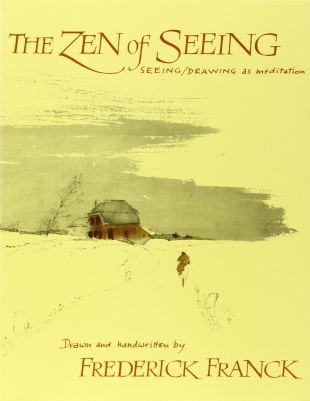Frederick Franck's classic 1973 work on drawing as a spiritual discipline is as fresh today as when it was first written. This paperback's evergreen quality has to do with its sparkling and effervescent celebration of the artist within every human being and the joy of being alive in a world of ten thousand things. While many of us go through life merely looking at things without much interest or passion, Franck challenges us to take up the discipline of seeing. Here’s how he introduces it to participants at a workshop:
"Let your eyes fall on whatever happens to be in front of you. It may be a plant or bush or a tree, or perhaps it is just some grass. Close your eyes for the next five minutes . . .
Now open your eyes and focus on whatever you observed before — that plant or leaf or dandelion. Look it in the eye, until you feel it looking back at you. Feel that you are alone with it on Earth! That it is the most important thing in the universe, that it contains all the riddles of life and death. It does! You are no longer looking, you are seeing."
He counsels us not to think about the drawing but to simply allow the hand to follow what the eye sees.
This approach to art, named "seeing/drawing" by Franck, is a form of meditation, "a way of getting into intimate touch with the vision world around us, and through it . . . with ourselves." Unwavering attention is all important. Through this approach we can pull down the walls that separate us from other people, animals, places, and things. The hundreds of wonderful drawings by Franck in the book offer proof positive that this discipline of pointed mindfulness yields abundant pleasures and delights.
In the following passage, the artist makes the connection of drawing to Zen meditation:
"The Zen of Seeing is a way from half-sleep to full awakening. Suddenly there is the miracle of being really alive with all the senses functioning:
" 'How wondrously strange and miraculous:
I draw water, I carry fuel.' "
Hokoji, eighth century
"How wondrously strange and miraculous: I see! I see a lettuce! I see you!"
"The ninth century Zen master Siubi was asked: 'What is the secret of Zen?'
" 'Come back when there is nobody around and I shall tell you.'
"The inquirer returned. Siubi took him to a bamboo grove, pointed at the bamboos and said:
" ' See how long these are. See how short these are!'
"Suddenly the questioner SAW, 'had a flash of awakening.'
"What did he see? He had a revelation of sheer existence.
"Where there is revelation, explanation becomes superfluous. Curiosity is dissolved into wonder."
Whether musing on his drawings of nature, cities, nudes, animals, faces, or crowds, Franck is the ultimate sensitive teacher who marshals a panoply of fascinating quotations and a treasure trove of interesting personal stories to round out his presentation. In the last analysis, the author evidences a healthy respect for the true self, also called the original face or the true person without label. As he puts it: "Becoming one with the lilies in seeing/drawing, I become not less, but more myself."
